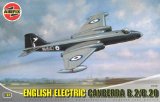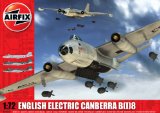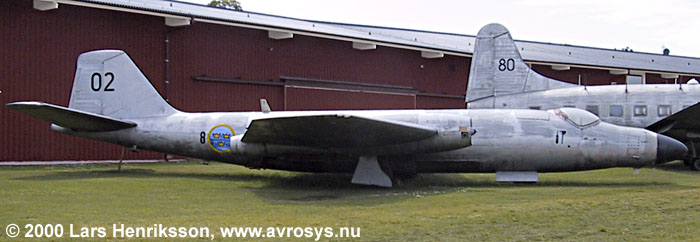|
|
||
| TP 52 - English Electric Canberra B.2 (1960-1974) | ||
| Page 1 (2) | ||
|
|
||
 |
||
|
Some
years after WWII began the Swedish Air Force a new activity,
"research flying" with direction to the electronic branch,
mostly radar and radio. The first aeroplane for this activity was a
converted B 3 (Junkers Ju 86K). It was written off in January 1957.
After WWII the Air Force also began more seriously with
Electronic Intelligence (ELINT). For the activity, two DC-3's were
procured. The designation of these planes was Tp 79. These Dakotas were
specially equipped and were run by FRA (Försvarets Radioanstalt = the
Radio Establishment of the Defence), often called just ”the
Business”. One of these
was shot down
by a Soviet MiG-15 over the Baltic Sea in June 1952. This loss of the DC-3 led
to procurement of a Vickers Varsity (Tp 82).
When
the Ju 86K research platform was written off and also the demand of
altitude performance of the ELINT aircraft increased, the Air Force
began to look for an aircraft suitable for both missions. The choice
fell on the English
Electric
Canberra. An agreement was made with English Electric concerning two
used, but totally overhauled and partly modified planes.
The
E E Canberra was from the beginning intended as a
nuclear-capable medium bomber. The design however showed a great
potential of further development and became manufactured in versions for
several other roles.
The
two aircraft E
E intended to sell were available on a base in Australia
and of the version Mk VII. They have not been used for seven months.
Their earlier mission had been as measurement aircraft in connection
with nuclear weapon tests. The both machines were flown to England for
overhaul and modification. During the work, severe corrosion damages
were found. It was caused by the fact that the aircraft had been sprayed
with water to clean them from radioactivity after the tests.
Unfortunately salt sea water had been used, and after half a year the
aircraft were so corroded that they were unusable. EE managed to find
two other airframes, however not Mk VII, but the older version B.2s.
These two aircraft carried the RAF serials WH711 and WH905. They were
given the Swedish Air Force numbers 52001 and 52002 and the designation TP 52. Except for the major overhaul, the aircraft were also
modified. The original nose cone was replaced with nose of type AI17,
and a radome adapted for the "S"-band. The same type of nose
cone was also installed on the T.11 Canberra version and was nicknamed
in Sweden as "the pencil". Furthermore most of the radio and
navigation equipment was removed and replaced with more modern equipment
of the Swedish Air Force standard.
In
January 1960 was 52001 ready for delivery and a crew from the Wing F8 of
Barkarby (near Stockholm, now closed) flew the Canberra from Preston home
to Sweden and the F8 Wing. A couple of months later, 52002 was flown
home. But before the two aircraft could be taken in active service,
they had to be modified and equipped for their respective duty concepts.
Generally the two planes went through the same modifications, but with
the reservation that 52001 should be used by the FRA for
ELINT, while 52002 should be used for research both by the Air
Force and for some civilian companies that had the Air Force as a
customer. In the bomb bay a big "rack" of profiles and plating
was build. On this rack different equipment could be installed; fixed
equipment for FRA in 52001 and more occasional installations in 52002.
As certain radar tests were to be carried out with 52002, an adapter of
glass fibre was built so it would be possible to mount the antenna used
for the radar developed for the all-weather attack plane SAAB A32
Lansen. 52001 was of course provided with a many and various antennas
for ELINT with, amongst others, three bladed, dorsal antennas and a
large antenna built into the fin. |
|
|
|
For the Model Builder Airfix has produced a plastic model kit of Canberra B.2/B20 in scale 1:48. It is exactly the same version as the Swedish Tp 52.Catalogue number A10101. Click on the thumbnail to get to Amazon's page about this model. |
 |
|
|
Airfix has also a plastic model kit of Canberra B(I) in scale 1:72. Catalogue number A05038. Click on the thumbnail to get to Amazon's page about this model. |
 |
|
|
Photo at top of
52001 taken by Christer Sidelöv in the fall of 1974 at Malmen. It is easy
to see that the aircraft have been fitted with new codes. |
||
 |
||
|
This photo shows 52002 exhibited at Flygvapenmuseum - still exposed to the Swedish weather. |
||
|
|
||
|
|
||
|
|
||
|
© Lars Henriksson |
|
Updated 2010-02-28 |
|
Custom Search
|
||